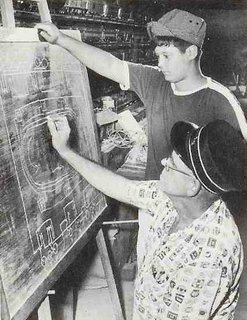 SIGNAL CIRCUIT DIAGRAM.
SIGNAL CIRCUIT DIAGRAM.E. Carl Pieper instructs Michael Bartoli of the "work crew" on how to determine how much trock and signal wiring will be needed to set up a new track area. The amount of track in use at the time exceeded one half mile, valued at more than $1,000.
"We never know," Pieper said, "when the phone is going to ring and someone will say: 'Mr. Pieper, I hear you have a fabulous railroad and my son is going to celebrate his birthday next week. I'd like to bring a group over with him to see the railroad.' "
He added that they always arrange to accommodate their visitors. The home of this LPIU family at 12 Hunters Lane is always open to visitors on Sundays.
They never charge admission.
In addition to the railroad, this charming New England house has its own "game" room upstairs, which includes, among other hospitality divertissements, its own pool table and its own outdoor swimming pool that is part of the "back of the house" and not "out there" in the backyard.
The Piepers always hope that some of their guests have trains they don't want, or will spread the word to others who have old unwanted trains, to give or sell them for their line.
In addition to the railroad itself visitors see a maze of bridges, crossing gates, floodlights, water towers, loading stations, electric plants, towns, trees, rivers, animals - and even an operating ski lift complex complete with tiny figures zooming down a mountain slope.
In their living room, to the right of the mantel is a 1903 Lionel train, one of their very first, along with other trains. The dining room features the oldest model train - approximately 100 years old.
A baggage or emergency lantern can be seen in the hallway. If electric power ever goes out - they can light the candle in the lantern. The den features wallpaper with trains as the pattern.
Marker lanterns can be seen in the playroom, more train models and a large old bronze bell of a Norfolk and Western freight locomotive that gongs and reverberates.
The cookie jar in the kitchen is a "Puffing belly" done in pottery, and the stairwell to the basement is lined with rosters of maior railroads. Toy train catalogues can be seen back to 1903.
The cost of the locomotives ranges between $15 and $500 and all equipment is itemized and insured.
The situation has changed since the Piepers moved to Norwalk. At that time Carl couldn't interest any adu1ts in his railroad. Finally, one neighborhood child became interested, then another, until finally all the youngsters in the neighborhood at one time or another have helped. After that, some of the parents became interested and one of them painted a lake scene to be used as a backdrop.
Now, the Friday night "work crew" is drawn from all over Norwalk.
Since all the trains are at least 30 years old and standard gauge is no longer manufactured, Carl does his own repair work and has a huge supply of spare parts.
To furnish enough electrical power to run the rail line, when he built the house, Carl put in a 200 ampere electrical service - enough for a small factory - and uses 150 for the house and 50 for the railroad.
The youngsters aren't allowed to run the trains when they first join the "crew." "They start out as gandy dancers - track walkers - and work up, job by job, to engineer, after which they're allowed to run the trains," Carl explained.
He has a regular "work roster" to keep track of work schedued for his helpers. With a laugh this boss added: "At the wages I pay, I can't afford to fire them." When they report on Friday, they check their duty lists, don their uniforms (regulation railroad caps with metal badges donated by the Great Northem) and tuck a blue and red bandanna in the back pocket of their jeans.
The boys learn all there is to know about model railroads - wiring, track laying, maintenance and repairs.
Carl, who has heen the Union's correspondent for both Locals 90p and 65P and is now Local 90p correspondent for the GRAPHIC ARTS UNIONIST, said:
"As much as I like to run these, I get an even bigger kick out of watching these kids learn model railroading."
"That's the real purpose C & E," agreed Emily.
 MAIN PASSENGER TERMINAL.
MAIN PASSENGER TERMINAL."Work crew" member Christopher "Dusty" Yost ond C & E Railroad Pres. E. Carl Pieper solder a broken wire on the bumper of a train sidetracked in front of the main passenger terminal of the rail line. The all chrome train on the right is on American Flyer display train which was featured at the 1933 World's Fair in Chicago. LPIU member Pieper says it is the most expensive train in his collection and would probably sell for $3,000. The youngsters learn from Carl all there is to know about model railroods.
Thanks to Mr. Cohen for helping me fill in some of the blanks on this article. Again, my apologies for the typos. This old typset is really nice to read and look at but can be a bear and a half to scan in. Please contribute to the blog, I'd love to hear some RECENT stories like this one.
Marc
1 comment:
Any idea what became of this man's great layout and collection?
Jim Kelly
Post a Comment